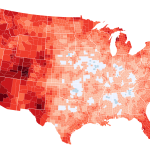The High-Stakes Gamble Over Latino Voters in Redistricting
The ongoing redistricting battles in Texas and California represent a high-stakes gamble by both Republicans and Democrats, with the outcome hinging on the voting patterns of Latino communities. This year’s aggressive redrawing of electoral maps, initiated by Texas Republicans and met with a counter-offensive from California Democrats, reveals a fundamental disagreement about the future political alignment of Latino voters. The stakes are immense, potentially deciding not just individual races but the overall balance of power in both states heading into the 2026 elections.
Texas Republicans’ Risky Strategy: A Rightward Shift?
Texas Republicans’ aggressive redistricting efforts are predicated on a key assumption: that the rightward shift observed among Latino voters in the last two presidential elections will continue, or at least that Latino voters will remain as reliably Republican as they were in 2024. This strategy reflects a belief that the Republican party is making inroads within the Latino community, potentially due to issues such as economic concerns or cultural considerations. However, this bet is risky. A significant portion of the Latino population remains firmly within the Democratic camp, and a failure to account for this could backfire spectacularly, leaving Republican gains vulnerable. The success of this strategy hinges on successfully appealing to a specific segment of the Latino population while potentially alienating others. Analyzing demographic shifts and voter turnout data within specific districts will be crucial in determining the effectiveness of this approach.
California Democrats’ Counter-Move: Maintaining the Status Quo?
In response to Texas’s actions, California Democrats are pursuing their own redistricting strategy, built on the assumption that Latino voters will remain loyal to the Democratic party. Their efforts focus on strengthening existing Democratic districts and creating new opportunities in currently competitive areas. This strategy aims to bolster Democratic representation in key battleground districts by concentrating Latino voters strategically. However, this approach carries its own inherent risks. If the observed rightward trend amongst some Latino voters continues or accelerates, the Democrats’ strategy could prove insufficient to counteract potential Republican gains. The effectiveness of this strategy depends on maintaining high voter turnout and enthusiasm among Latino Democrats.
The 2026 Elections: A Critical Test
The outcome of the redistricting battles in both states will significantly impact the 2026 elections. The success or failure of both the Republican and Democratic strategies will be a critical test of their understanding of the evolving political landscape and the changing dynamics of the Latino vote. Independent analysis of the newly drawn districts, including demographic breakdowns and historical voting patterns, will be essential to assess the potential impact on election results. The choices made now will have profound consequences for future elections, highlighting the importance of understanding and responding to the complexities of the Latino electorate. The data-driven approach of tracking voter registration and turnout will be critical in assessing the impact of this redistricting war. The battle for the Latino vote promises to be a defining characteristic of the upcoming election cycle.
Based on materials: Vox





